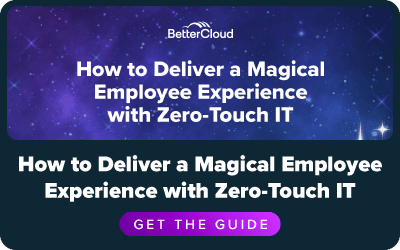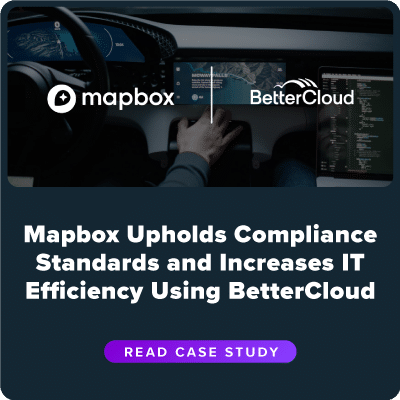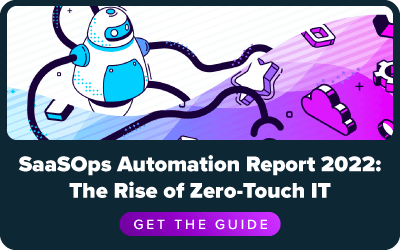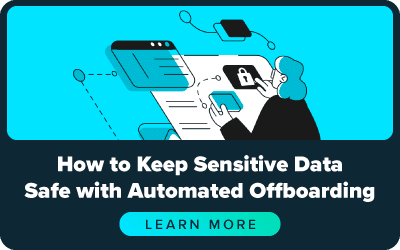Everything IT Needs to Know About SaaS Operations Management
August 9, 2022
6 minute read

In 2018, 451 Research validated the rise of an IT market category BetterCloud had been pioneering for years: SaaS Operations Management, or SOM. The rise of remote work, along with the rapid growth of SaaS adoption, continuously create new and unique operational challenges for IT.
IT teams at companies with large SaaS stacks can spend hours of time on manual, repetitive tasks, such as adding and removing user accounts. Numerous security risks, from data breaches to shadow IT, have been added to IT’s threat landscape. Fully onboarding new hires can take days or even weeks, giving them a slow, frustrating start with their new role. SaaS app access requests from remote employees are burying help desks in mountains of tickets.
SaaS operations management (SOM) is a framework for giving IT the strategies and tools needed to tackle these challenges. In this article, we’ll take a close look at everything IT needs to know about SOM, including:
- What is SaaS operations management?
- How does a SaaSOps management strategy benefit IT teams?
- What does SaaS operations management software do?
- What are some SaaS operations management use cases?
With new SaaS apps being added to IT environments every day, teams can easily get overwhelmed with repetitive work, including access requests, threat remediation, and more. With a SaaS operations management strategy—along with a skilled SaaSOps team and a fully featured SaaS management platform—IT can not only overcome these challenges, but transform their work from reactive ticket-takers to strategic business partners.
To learn more about how CIOs can transform their IT strategy with a SaaS operations management framework, check out our ebook, The Strategic CIO: How to Evolve IT from a Reactive Cost Center to a Strategic Partner.

What is SaaS operations management?
To keep SaaS applications running effectively in their environment, IT teams end up with numerous operational admin and security tasks. SaaS operations management is a strategy for automating these repetitive, mundane tasks in order to effectively manage a large SaaS stack.
There are two parts to SOM:
- Defining acceptable use policies for SaaS apps.
- Using SaaS operations management software, such as a SaaS management platform, to execute and automate those policies.
IT teams can use a SOM strategy to create, enforce, and optimize everyday usage policies for mission critical SaaS applications.
How does a SOM strategy benefit IT teams?
When an IT team implements a SaaS operations management strategy with a SaaS management platform (SMP), they improve the way their own department and the company as a whole works. Let’s take a look at three of the biggest benefits.
Improved Efficiency
At the core of a SOM strategy is automation. By using an SMP to automate the operational processes of SaaS management, hours can be saved each time the process is completed.
For example, take the long, complex processes of employee onboarding and offboarding. By automating these processes with an SMP, IT teams in companies like Superfly have gotten back up to 85% of the time they were previously spending on user lifecycle management.
Better Employee Experience
By using a SOM strategy to optimize the use of SaaS, IT teams can improve employee collaboration while saving on cost. With an SMP, IT teams can discover all the apps in use in their IT environment, including unsanctioned apps (also known as shadow IT.) Then, IT can strategically consolidate usage or add new apps to improve productivity and employee experience.
At the core of a SOM strategy is automation, which enables IT teams to spend less time on repetitive SaaS administration tasks. App access request tickets can be fully automated using a zero-touch workflow created in an SMP. With less time spent resolving tickets and managing SaaS apps, IT teams can spend more time on strategic work. When IT teams don’t have to spend 90% or more of their time dealing with tickets and SaaS administration, they have the ability to develop new skills, grow their careers, and take on more meaningful projects.
Centralized Data Protection
The more SaaS you have in your IT environment, the greater your security risks are. Well-meaning employees using the most popular file sharing apps, like Google Drive and Dropbox, are just one click away from causing a major data breach. They also have a tendency to use shadow IT, granting apps OAuth access to your environment with IT ever being aware. Without centralized, granular app access control, far too many accounts with super admin privileges are created—increasing the risk of unauthorized access or accidental misconfiguration.
With a SaaS operations management strategy, you can define and enforce a number of important security and compliance policies. IT teams can create workflows in an SMP to automatically revoke access to shadow IT, or unshare files that contain sensitive or proprietary data. This way, you can quickly and proactively address the security threats introduced by SaaS sprawl with automated threat remediation.
How does SaaS operations management software help?
To get all the benefits of a SaaS operations management strategy, you need the right tool. SaaS operations management software, also known as a SaaS management platform, should have a full range of features and capabilities that enable IT teams to discover, manage, and secure their SaaS stack.
A SaaS operations management platform should provide a single, powerful location for no-code automation, threat remediation, intelligent alerting, and actionable insights. If an IT team fully leverages all the capabilities of a SOM platform, they can realize major time and cost savings, decrease their threat landscape, and ensure a great employee experience.
The marketplace for SaaS operations management tools can seem daunting and complex, if your team is looking for the right solution. However, Gartner has clearly defined all the capabilities a fully featured solution should have. If you want to deep dive into all the ways SaaS operations management software can help, this comprehensive SaaS management platform buying checklist has everything IT needs to know to buy the right tool for your environment.

What are some SaaS operations management use cases?
A SaaS operations management strategy can be applied to many IT operational processes to save time, decrease security risks, and improve the employee experience. Let’s look at a few of the most common use cases that deliver some of the highest return on investment (ROI).
Employee Onboarding and Offboarding
Automating employee onboarding and offboarding processes with SaaS operations management platform delivers many benefits to both IT and the entire organization. New hires can get the access they need to be productive right away with automated onboarding workflows.
As soon as an employee departs, you can revoke access to apps in minutes, keeping your environment safe from potentially destructive or risky actions. For security and compliance, a SaaS operations management platform can easily provide a record of enforcing your offboarding policies with non-expiring logs.
File Security
File sharing apps are designed to be very easy to use. In minutes, an employee can add sensitive information to a Google Doc and share it with an external contact. With a SaaS operations management platform, you can easily locate sensitive data, no matter where in your IT environment it lives. You can also set up automated remediation workflows that unshare files and notify IT and managers.
Access Control
Implementing least privilege access and other access control policies is another important use case for SaaS operations management. Using a SaaS operations management platform, you can create and enforce policies around how many super admin accounts are allowed for each app. Anyone in your IT department can use the platform itself to manage apps, reducing the need for more than one super admin account per app. Automated workflows can also be created to automatically revoke access if someone tries to create too many super admin accounts.
Conclusion
Success in a modern IT environment—filled with SaaS apps and remote workers— requires a specialized approach and the right tools. A SaaS operations management strategy, along with a SOM platform (or SMP), gives IT the ability to create and enforce policies for administering SaaS. Once in place, these strategies and platform capabilities improve the day-to-day work for IT and other departments, by saving time, boosting productivity, and keeping data secure.
To learn more about how BetterCloud can deliver improved efficiency, data protection, and a better employee experience, schedule a demo.














